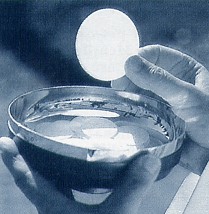In 1950, Pope Pius XII defined Mary's Assumption into heaven as a dogma of Roman Catholicism: "the Immaculate Mother of God, the ever Virgin Mary, having completed the course of her earthly life, was assumed body and soul into heaven." The proclamation was made in the encyclical Munificentissimus Deus. After entering heaven, Mary remains active in the life of the Church.
The Solemnity of the Assumption
of the Blessed Virgin Mary
of the Blessed Virgin Mary
August 15
"Today, she who "belongs to Christ" by a unique, abiding, and unrepeatable privilege, the most holy Theotokos and ever-virgin Mary, follows where He has gone, "through the greater and more perfect tent not made by human hands, that is, not of this creation . . . into the Holy Place" (Heb 9:11). Today the sacred and living ark of the living God, who conceived her Creator Himself, takes up her abode in the temple of God St John
__________________________________
Assumpta est Maria in caelum, gaudent angeli, laudantes benedicunt Dominum!
Mary has been taken up into heaven;
"Above all, let us listen to Mary Most Holy,
in whom the mystery of the Eucharist appears,
more than in anyone else, as a mystery of light.
Gazing upon Mary, we come to know
the transforming power present in the Eucharist.
In her we see the world renewed in love.
Contemplating her, assumed body and soul
into heaven, we see opening up before us
those 'new heavens' and that 'new earth'
which will appear at the second coming of Christ.
Here below, the Eucharist represents their pledge,
and in a certain way, their anticipation:
Here below, the Eucharist represents their pledge,
and in a certain way, their anticipation:
'Veni, Domine Iesu!'’” (Rev 22:20).
St John Paul II, Ecclesia de Eucharistia, 62
Painting: Assumption of the Blessed Virgin Mary, artist unknown

Painting: Assumption of the Blessed Virgin Mary, artist unknown
"And now death came; not indeed clothed in mourning and grief, as it does to others, but adorned with light and gladness. But what do we say? Why speak of death? Let us rather say that divine love came, and cut the thread of that noble life. And as a light, before going out, gives a last and brighter flash than ever, so did this beautiful creature, on hearing her Son's invitation to follow him, wrapped in the flames of love, and in the midst of her loving sighs, give a last sigh of still more ardent love, and breathing forth her soul, expired. Thus was that great soul, that beautiful dove of the Lord, loosened from the bands of this life; thus did she enter into the glory of the blessed, where she is now seated, and will be seated, Queen of Paradise, for all eternity." - St Alphonsus de Liguori

"The Solemnity of the Assumption of the Blessed Virgin Mary, the oldest Marian Feast, returns every year in the heart of summer. It is an opportunity to rise with Mary to the heights of the spirit where one breathes the pure air of supernatural life and contemplates the most authentic beauty, the beauty of holiness. The atmosphere of today’s celebration is steeped in paschal joy. “Today”, the antiphon of the Magnificat says, “the Virgin Mary was taken up to Heaven. Rejoice, for she reigns with Christ for ever. Alleluia”. This proclamation speaks to us of an event that is utterly unique and extraordinary, yet destined to fill the heart of every human being with hope and happiness.
Mary is indeed the first fruit of the new humanity, the creature in whom the mystery of Christ – his Incarnation, death, Resurrection and Ascension into Heaven – has already fully taken effect, redeeming her from death and conveying her, body and soul, to the Kingdom of immortal life.
For this reason, as the Second Vatican Council recalls, the Virgin Mary is a sign of certain hope and comfort to us (cf. Lumen Gentium, n. 68). Today's feast impels us to lift our gaze to Heaven; not to a heaven consisting of abstract ideas or even an imaginary heaven created by art, but the Heaven of true reality which is God Himself. God is Heaven. He is our destination, the destination and the eternal dwelling place from which we come and for which we are striving."
- Pope Benedict XVI - August 15, 2008 (Homily)
Click here: Apostolic Constitution defining the Dogma of the Assumption - Munificentissimus Deus
Click here: Scott Hahn on the Assumption of the Blessed Virgin Mary - YouTube
What is the Assumption of Mary? - YouTube (9:30 mins)
Click here: Scott Hahn on the Assumption of the Blessed Virgin Mary - YouTube
What is the Assumption of Mary? - YouTube (9:30 mins)



No comments:
Post a Comment